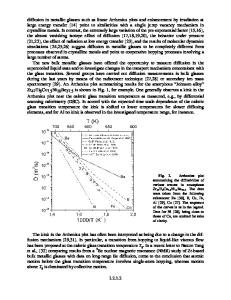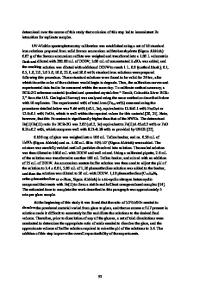Iron Redox Reactions in Model Nuclear Waste Glasses and Melts
- PDF / 548,702 Bytes
- 9 Pages / 612 x 792 pts (letter) Page_size
- 19 Downloads / 377 Views
1124-Q03-02
Iron Redox Reactions in Model Nuclear Waste Glasses and Melts Benjamin Cochain1,2, Daniel R. Neuville2, Jacques Roux2, Dominique de Ligny3, Denis Testemale4, Olivier Pinet1 and Pascal Richet2 1
CEA, DEN, DTCD, SECM, LDMC, Bagnols-sur-Cèze, France CNRS-IPGP, Physique des Minéraux et des Magmas, Paris, France 3 LPCML, UCBL, Lyon, France. 4 Institut Néel, MCMF, Grenoble, France 2
ABSTRACT The influence of boron on the kinetics of oxidation of iron in silicate melts relevant to nuclear waste storage has been investigated by XANES experiments. The measurements have been performed isothermally as a function of time at the iron K-edge. The redox kinetics become slower with increasing B2O3 content either close to the glass transition range, where the redox kinetics are controlled by diffusion of network-modifying cations, or at superliquidus temperatures where oxygen diffusion is the rate-limiting factor. In both ranges the kinetics can be interpreted in terms of boron speciation and interaction with alkali cations. Below the liquidus, however, the long times needed to reach redox equilibrium allow sintering of the powders investigated to take place so that the resulting changes in sample geometry prevent determinations of oxidation kinetic parameters from being made. INTRODUCTION Borosilicate glasses are privileged materials for nuclear waste storage because they allow a wide variety of elements to be incorporated in a stable and compact matrix. These glasses include various multivalent elements (Ce4+/Ce3+, Cr4+/Cr3+, Fe3+/Fe2+) whose redox state influences the vitrification process as well as the properties of the final material. For iron, the multivalent element which is most readily amenable to experimental studies, this influence is complex because not only the abundance but also the structural role of Fe2+ and Fe3+ ions depend markedly on temperature, chemical composition and oxygen fugacity [1]. Knowledge of the iron redox ratio is thus important to control processes such as elaboration and crystallization, to optimize the physical properties of glasses and to ensure in this way their longterm durability. The dependence of the iron redox ratio on intensive thermodynamic variables can be estimated accurately with empirical models for chemically simple or complex silicate melts [2,3]. But these models do not deal with borosilicate melts, because of the lack of relevant experimental redox data and, in view of their thermodynamic nature, they do not address at all the kinetics and the mechanisms of the redox reactions. Hence, our goal is to determine how the presence of boron in melts affects the equilibrium redox state and the kinetics of iron redox reactions to gain information on the mechanisms of these reactions through determination of rate limiting parameters. As a matter of fact, it has long been assumed that redox reactions are rate limited by diffusion of either molecular or ionic oxygen [4,5]. However, at supercooled liquid temperatures (i.e. near the glass transition temperature range), extensiv
Data Loading...











